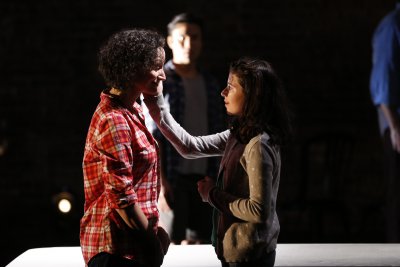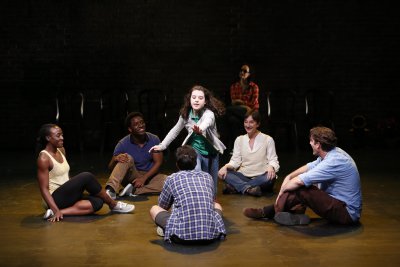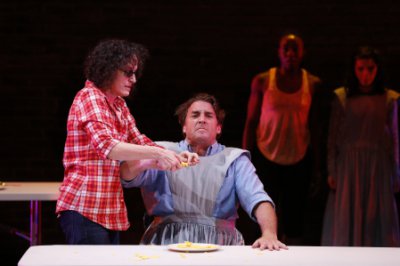Three Days to See
After a weak start, this becomes a very moving portrait of Helen Keller in her own words: witty, wise and poignant.

Barbara Walsh as Anne Sullivan and Zoe Wilson as the young Helen Keller in a scene from “Three Days to See” (Photo credit: Carol Rosegg)
[avatar user=”Victor Gluck” size=”96″ align=”left” ] Victor Gluck, Editor-in-Chief[/avatar] After a weak and off-putting start, Three Days to See, A reawakening of Helen Keller in her own words, becomes a very witty, wise and poignant dramatization of the life and ideas of the famous lady who overcame blindness and deafness to become a spokesperson for the disenfranchised. Conceived and directed by Transport Group Theatre Company’s artistic director Jack Cummings III (with an assist from dramaturg Kristina Corcoran Williams), Three Days to See is both a play for voices and a dramatization of scenes from Keller’s life using excerpts from her letters and 12 published books.
Using a versatile cast of seven (Ito Aghayere, Patrick Boll, Marc delaCruz, Theresa McCarthy, Chinaza Uche, Barbara Walsh, and Zoe Wilson) who all play both Helen Keller and her teacher Anne Sullivan at some point in the evening, Three Days to See will impress you with the courage of this remarkable woman and remind you how grateful you should be for having your five senses unimpaired. While Keller’s early life was brilliantly dramatized in William Gibson’s The Miracle Worker, that play and movie only dealt with Keller at age seven. Three Days to See tells the rest of the story as well as gives us insight into her beliefs, ideas and causes to which she was passionately devoted.
Three Days to See is not told strictly chronologically but thematically. For those unfamiliar with the details of Keller’s life she was born in Alabama in 1880 and at age 18 months came down with an illness which left her deaf and blind, and as a result, also mute. Her parents not knowing what to do allowed her to rampage through the house in her benighted state. Finally, when she was seven, Anne Sullivan, a young teacher from the Perkins Institute for the Blind, came to educate her in Braille and the manual alphabet. The ensuing battle between them before Helen understood what Teacher was trying to tell her through her fingers has been dramatized in The Miracle Worker.

(Clockwise from left) Ito Aghayere, Chinaza Uche, Zoe Wilson, Barbara Walsh (rear), Theresa McCarthy, Patrick Boll and Marc delaCruz (foreground) in a scene from Three Days to See (Photo credit: Carol Rosegg)
The new play starts with jokes at Helen Keller’s expense that become more and more coarse. This may be intended to break the ice or remind us of a time when it was acceptable to laugh at people with physical disabilities. The two most famous scenes in Keller’s autobiography of her early years, The Story of My Life, are dramatized but differently than you have seen them before. Wilson retells the story of seven-year-old Helen’s breakthrough with Teacher when she began to acquire language: Sullivan poured water over her while furiously spelling the word into her hand with the manual alphabet, performed here without the iconic pump. With Walsh as Sullivan, the entire cast reenacts the story of her food fight with Helen about eating with a fork and not taking food off other people’s plates. This physical and fast paced scene leaves all of the actors breathless by the end.
We learn of Keller’s reading in Braille, thick volumes that take much time, such as Gone with the Wind, King Lear, Little Women and Little Lord Fauntleroy, but also the great poets and the great philosophers. We hear how Keller’s years at Radcliffe College (she was the first deaf blind person to earn a Bachelor of Arts degree) were lonely as only one classmate learned the manual alphabet and was able to converse with her. We learn of her meetings with the greats of her time (Mark Twain, Alexander Graham Bell and Charlie Chaplin). We hear that besides writing magazine articles, Keller and Sullivan go on the vaudeville stage when their money runs out and travel all over the country and the world (France, India, Japan, Scotland, Hollywood.)
Three Days to See also relates the social and political education of Helen Keller which is not handled in the other reenactments of her life. In her travels around the U.S., she comes to realize that she owed her success partly to the advantages of her birth and environment and that “the power to rise in the world is not within the reach of everyone.” As a result she takes up the causes of women’s suffrage, wage inequality, birth control, racism, labor rights, and socialism, finding that her advanced and liberal views make it harder for her ideas to get a hearing.

Barbara Walsh as Anne Sullivan and Patrick Boll as Helen Keller in a scene from Three Days to See (Photo credit: Carol Rosegg)
The last segment of the play is taken from Keller’s famous and much anthologized essay which gives the play its title. Having noticed that the seeing see little and take much for granted, she muses on what she would do if through a medical miracle she were given three days to see. The entire cast alternately recounts and acts out Keller’s choices for both her days and evenings. This section is a moving tribute to mankind’s achievements and as directed by Cummings, the pace quickens until the finale is a veritable crescendo of triumph.
The multiracial cast alternates delivering the text, with each of the performers excelling in one area or another. Barbara Walsh usually plays an authoritative Anne Sullivan, while Zoe Wilson is mainly the young wide-eyed Helen. Patrick Boll makes excellent use of his height and breadth. Ito Aghayere and Chinaza Uche often speak for the underdogs in society. Dane Laffrey is responsible for the flexible set design and the casual contemporary costumes. Walter Trarbach’s sound design incorporates songs from well-known musicals and soundtracks that we unconsciously associate with many of the themes discussed. The lighting by R. Lee Kennedy always leads our eyes to the part of the stage where the action is taking place.
Jack Cummings III’ Three Days to See presented by the innovative Transport Group Theater Company is a tribute to a remarkable woman and a reminder of how much we take for granted. Ultimately a very moving theatrical experience, the play is a treat for the ear as well as the eye. You will have a new appreciation of the extraordinary Helen Keller whose life remained a battle even when she had become world famous.
Three Days to See (through August 16, 2015)
Transport Theatre Group
Theatre 79, 79 East 4th Street, in Manhattan
For tickets, call 212-564-0333 or visit http://www.transportgroup.org
Running time: 115 minutes with no intermission






Leave a comment